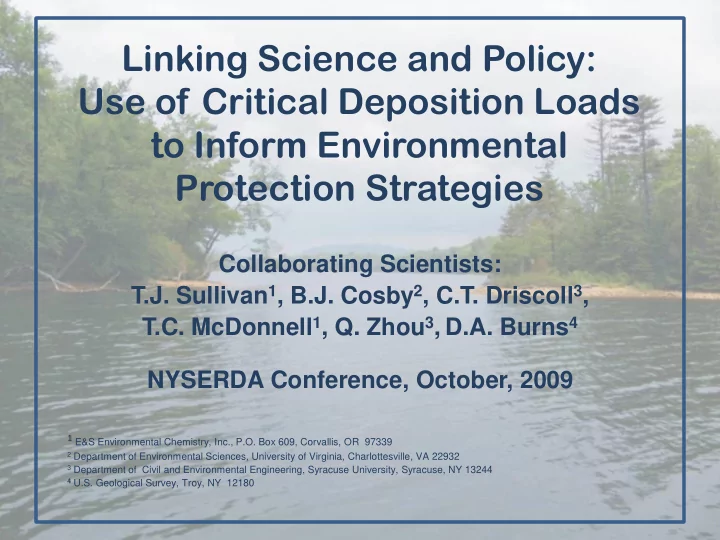

Linking Science and Policy: Use of Critical Deposition Loads to Inform Environmental Protection Strategies Collaborating Scientists: T.J. Sullivan 1 , B.J. Cosby 2 , C.T. Driscoll 3 , T.C. McDonnell 1 , Q. Zhou 3 , D.A. Burns 4 NYSERDA Conference, October, 2009 1 E&S Environmental Chemistry, Inc., P.O. Box 609, Corvallis, OR 97339 2 Department of Environmental Sciences, University of Virginia, Charlottesville, VA 22932 3 Department of Civil and Environmental Engineering, Syracuse University, Syracuse, NY 13244 4 U.S. Geological Survey, Troy, NY 12180
Roadmap for Today’s Talk Critical load: What is it? How is it calculated? How is it used? Some examples: Virginia and West Virginia – Steady State Model Approach Shenandoah National Park – Dynamic Model Approach What are we doing in New York?
What is a critical load? What are the sensitive receptors that we want to protect? How is a critical load calculated? How can the critical load concept be used?
Major Decision Points • Aquatic vs terrestrial • Acidification vs nutrient enrichment • Steady state vs dynamic • Critical load vs target load • Chemistry vs biology • Site-specific vs regional • What other factors must be considered in calculating a critical or target load?
Biological Critical Indicators Receptors Chemical Criteria Limit Units Fish; other Surface water ANC 0, 20, 50 μ eq/L - concentration aquatic chemistry NO 3 5, 20 μ eq/L biota Forest Soil B horizon Base saturation 10, 15 % health chemistry Soil solution Ca:Al molar ratio 1, 10 Unitless (B-horizon) chemistry N uptake Tree foliar Foliar N TBD TBD chemistry concentration (species TBD) Chemical ratio TBD TBD (TBD)
Example Models for Calculating Critical Loads: 1) Steady State Water Chemistry Model CL(A) = BC dep +BC w – Bc up – ANC limit 2) Dynamic Model MAGIC PnET-BGC
It’s mostly about weathering!
A Steady State Example: Regional Application of SSWC to Streams in VA and WV
What to do about weathering? 1) Simulate weathering at 92 sites using MAGIC 2) Extrapolate MAGIC estimates of weathering to the region 3) Model regional CLs using SSWC 4) Assign CLs to individual stream reaches 5) Calculate CL exceedances
BC w Predictor Variables • Landscape Characteristics – Watershed Area – Elevation – Slope – Geologic classes – Soil variables (% clay, pH, depth)
• Water Chemistry (500+ sites) – Sum of base cations – Sum of base cations – chloride – ANC – Sulfate – Nitrate
Predicting BC w from Available Spatial Data r 2 Ecoregion n Predictor Variables With Water Chemistry: Central Appalachian 24 SBC 0.93 NO 3 WS Area Ridge & Valley 42 SBC 0.85 Elevation (-) Slope (-) Blue Ridge 26 ANC 0.90 NO 3
r 2 Ecoregion n Predictor Variables Without Water Chemistry: Central Appalachian 24 Soil pH (-) 0.66 WS Area Elevation (-) Ridge & Valley 42 % Siliciclastic (-) 0.64 % Carbonate Elevation (-) Blue Ridge 26 % Siliciclastic (-) 0.86 Soil % Clay Soil Depth (-)
Steady State Water Chemistry Model (SSWC) CL(A) = BC dep +BC w – Bc up – ANC limit
Time to Steady State ANC ( μ eq/L) Starting 2020 Using SSWC Critical Loads ANC 20 (n = 45) ANC 50 (n = 54) 70 60 % of Recovering Streams 50 40 30 20 10 0 0 - 50 yrs 50 - 200 yrs 200 - 500 yrs > 500 yrs
Shenandoah National Park
Things to move from the back of your mind to the front of your mind when addressing critical and target loads 1. Time frame matters. 2. There are multiple possible chemical indicators; each relates somehow to biology. 3. Do you want to base policy on one lake or one stream? You need to know about the broader population of lakes and/or streams.
4. Most lakes or streams in a given region are generally NOT acid-sensitive (critical load is very high). Focus on the relatively small number of waters that are sensitive. 5. Some acidified lakes and streams are not projected to recover to critical criteria values even if deposition is reduced to zero because they were not that high to begin with. 6. It’s important to separate the science (objective) from the policy (judgment). The science is reflected in the modeling. There are MANY policy judgments to be made, and they should be clearly documented.
Recommend
More recommend